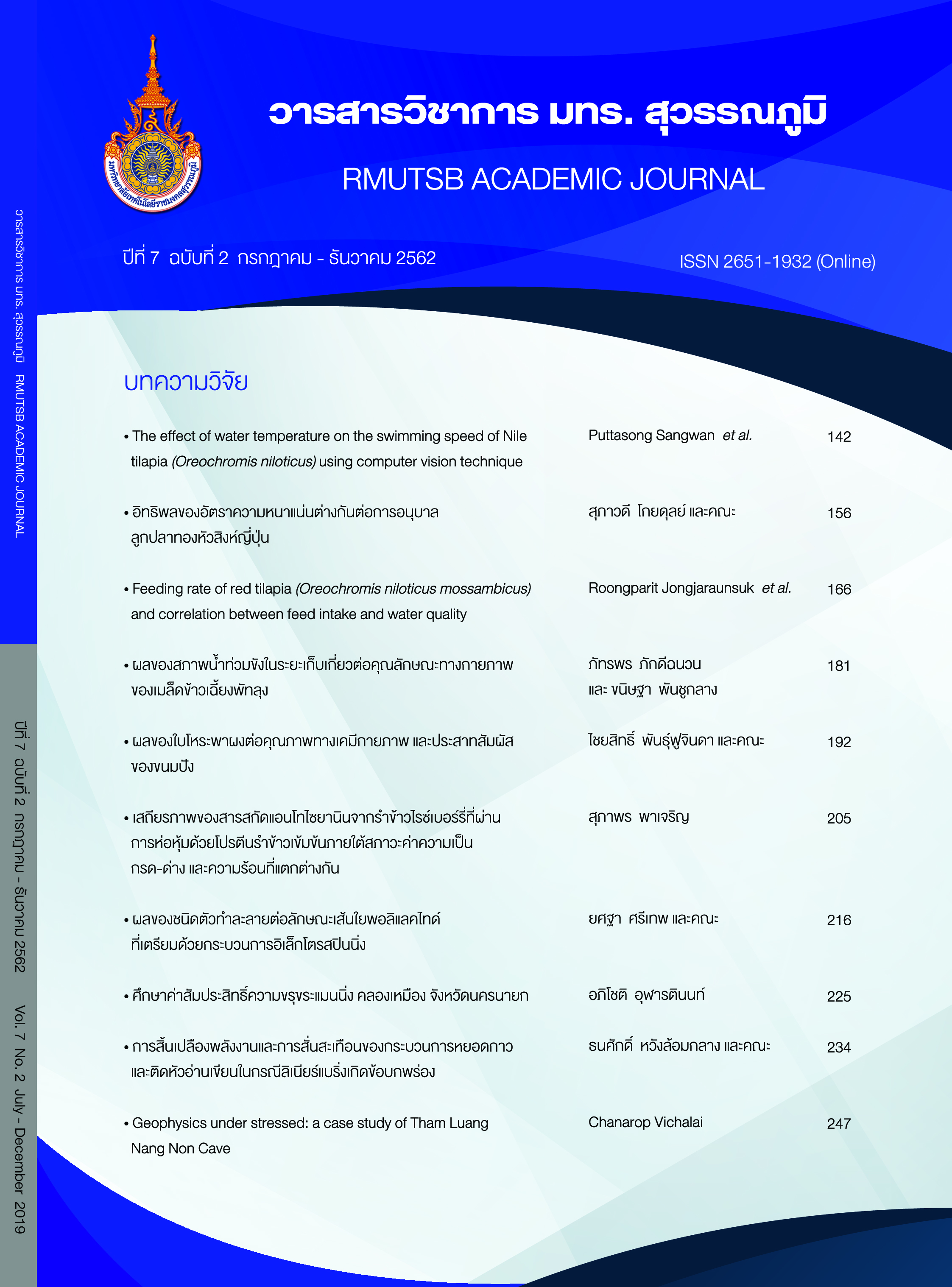Effect of solvents on polylactide fiber morphology prepared by electrospinning process
Main Article Content
Abstract
Nanofibers have been used in the industries and biomedical applications for years. This research aimed to study the effect of different solvents on the morphology of polylactide (PLA) nanofibers prepared by electrospinning process. Polylactide was dissolved in difference solvents like acetone, chloroform, and dichloromethane. The ratio of polylactide and solvents was 10 and 90 by weight. The solvents used in this study were acetone, chloroform and dichloromethane. Moreover, the effects of fiber spinning using mixed solvents were studied. In which the polymer solution was spun by the electrospinning machine. The flow rate was 1 millimeter per hour, the distance between the capillary needle and the drum collector was 15 centimeter, the voltage was 15 kilovolts and the spinning time was 3 hours. The morphology and size of nanofibers were determined. The results showed that the nanofibers produced by the mixed of acetone/chloroform at the ratio of 35/65 by weight had the most consistent and the lowest average diameter of 1253.18 nanometer.
Article Details
Published manuscript are the rights of their original owners and RMUTSB Academic Journal. The manuscript content belongs to the authors' idea, it is not the opinion of the journal's committee and not the responsibility of Rajamangala University of Technology Suvarnabhumi
References
Agarwal, S., Wendorff, J. H., & Greiner, A. (2008). Use of electrospinning technique for biomedical applications. Polymer, 49, 5603-5621.
Breuer, O., & Sundararaj, U. (2004). Big return from small fibres: a review of polymer/carbon nanotubes composites. Polymer composites, 25, 630-644.
Casasola, R., Thomas, N. L., Trybala, A., & Georgiadou, S. (2014). Electrospun poly lactic acid (PLA) fiber: Effect of different solvent system on fiber morphology and diameter. Polymer, 55, 4728-4737.
Datta, R., & Henry, M. (2006). Lactic acid: Recent advances in products, processes and technologies a review. Journal of Chemical Technology & Biotechnology, 81, 1119-1129.
Doshi, J. & Reneker, D. H. (1995). Electrospinning process and applications of electrospun fibers. Journal of Electrostatics, 35, 151-160.
Fong, H., Chun, I., & Reneker, D. (1999). Beaded nanofibers formed during electrospinning. Polymer, 40, 4585-4592.
Karakas, H. (2015). Electrospinning of nanofibers and their applications. Istanbul: Textile Technologies and Design Faculty, Istanbul Technical University.
Kanani, A. G., & Bahrami, S. H. (2010). Review on electrospun nanofibers scaffold and biomedical applications. Trends Biomaterial Artificial Organs, 24, 93-115.
Kenawy, E. R., Bowlin, G. L., Mansfield, K., Layman, J., Simpson, D. G., & Sanders, E. H. (2002). Release of tetracycline hydrochloride from electrospun poly(ethylene-co-vinylacetate), poly(lactic acid), and a blend. Journal of Controlled Release : Official Journal of the Controlled Release Society, 81, 57-64.
Khil, M., Cha, D., Kim, H., Kim, I., & Bhattarai, N. (2003). Electrospun nanofibrous polyurethane membrane as wound dressing. Journal of Biomedical Materials Research Part B Applied Biomaterial, 67, 675-679.
Shi, X., Zhou, W., Ma, D., Ma, Q., Bridges, D., Ma, Y., & Hu, A. (2015). Review article electrospinning of nanofibers and their applications for energy devices. Journal of Nanomaterials, 2005, 1-20.
Tucker, N., Stanger, J. J., & Staiger, M. P. (2012). The history of the science and technology of electrospinning from 1600 to 1995. Journal of Engineered Fibers and Fabrics, 7, 63-73.
Weber, C. J, Haugaard, V., Festersen, R., & Bertelsen G. (2002). Production and applications of biobased packaging materials for the food industry. Food Additives & Contaminants, 19, 172-177.
Yang, F., Murugan, R., Wang, S., & Ramakrishna, S. (2005). Electrospinning of nano/micro scale poly(L-lactic acid) aligned fibers and their potential in neural tissue engineering. Biomaterials, 26, 2603-2610


